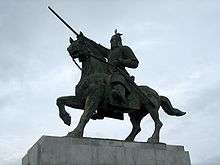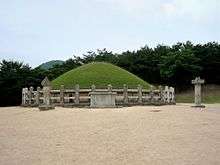Kim Yu-sin
| Kim Yu-sin | |
 His statue in Namsan Park, Seoul, South Korea | |
| Korean name | |
|---|---|
| Hangul | 김유신 |
| Hanja | 金庾信 |
| Revised Romanization | Kim Yu Shin |
| McCune–Reischauer | Kim Yu Shin |
Kim Yushin (595 – 18 August 673) was a general in 7th-century Silla. He led the unification of the Korean peninsula by Silla under the reign of King Muyeol of Silla and King Munmu of Silla. He is said to have been the great-grandchild of King Guhae of Geumgwan Gaya, the last ruler of the Geumgwan Gaya state. This would have given him a very high position in the Silla bone rank system, which governed the political and military status that a person could attain.
Much of what is known about Kim's life comes from the detailed account in the Samguk Sagi, Yeoljeon 1-3, and the much briefer record in the Samguk Yusa, vol. 1.
Early years
Kim Yushin was the son of General Kim Seohyeon (the second son of General Kim Mu-ryeok) and Lady Manmyeong, who was a daughter of Kim Sukheuljong (hangul 김숙흘종 hanja 金肅訖宗, King Jinheung of Silla's younger brother). He was born in Gyeyang, Jincheon County in 595, became a Hwarang warrior at just 15 and was an accomplished swordsman and a Gukseon (국선, 國仙; Hwarang leader) by the time he was 18 years old. By the age of 34 (in 629) he had been given total command of the Silla armed forces. Three years later, Kim Yushin's cousin, Princess Deokman, became Queen Seondeok of Silla and kept Kim Yushin as commander in chief of the royal army. During the reign of Queen Seondeok of Silla (632-647), Kim Yushin owned ten thousand private soldiers, won many battles against Baekje and became one of the most powerful man in Silla.
Military accomplishments

Yushin's first military engagement in command is believed to have occurred around 629 AD, and through it he quickly proved his capabilities as a warrior. Silla was in a constant struggle with its neighbor to the west, Baekje, over territory. There had been gains and losses on both sides, and the struggle lasted for many years. It was during this period that Yushin rose through the ranks of the military, rising to the position of general and becoming a skilled field commander.
Baekje and Shilla had formed an alliance to counter Goguryeo's power and its intentions to push southwards, and together they launched a successful attack on it, Silla taking the northern territory and Baekje the one south of the Han river. But Silla broke the alliance and attacked Baekje in order to claim both territories for itself. After this betrayal, Baekje allied with Goguryeo. When Goguryeo and Baekje attacked Silla in 655, Silla joined forces with Tang Dynasty China to battle the invaders. Although it is not clear when Kim Yushin first became a general, he was certainly commanding the Silla forces by this time. Eventually, with the help of the Silla navy and some 130,000 Tang forces, Yushin attacked the Baekje capital, Sabi, in 660, in one of the most famous battles of that century, the Battle of Hwangsanbeol.
The Baekje defenders were commanded by none other than General Gyebaek, although the Baekje forces consisted of about 5,000 men and were no match for Yushin's warriors, which numbered about ten times as many. Baekje, which had already been experiencing internal political problems, crumbled. Kim Yushin's Silla forces and their Tang allies now moved on Goguryeo from two directions, and in 661 they attacked the seemingly impregnable Goguryeo kingdom, but were repelled. The attack had weakened Goguryeo, though. In 667 another offensive was launched which, in 668, finally destroyed Goguryeo.
Silla still had to subdue various pockets of resistance, but their efforts were then focused on ensuring that their Tang allies did not overstay their welcome on the peninsula. After some difficult conflicts, Silla eventually forced out the Tang troops and united the peninsula under their rule.
Legends
Many stories exist about Kim Yushin. It is told that he once was ordered to subdue a rebel army, but his troops refused to fight as they had seen a large star fall from the sky and took this to be a bad omen. To regain the confidence of his troops, the General used a large kite to carry a fire ball into the sky. The soldiers, seeing the star return to heaven, rallied and defeated the rebels. It is also related how General Kim ingeniously used kites as a means of communication between his troops when they had become divided between islands and the mainland.
Another story relates how, while Silla was allied with the Tang Dynasty against Baekje, an argument broke out between Yushin's commander and So Jung-Bang, a Tang general. As the argument escalated into a potentially bloody confrontation, Kim Yushin's sword was said to have leaped from its scabbard into his hand. Because the sword of a warrior was believed to be his soul, this occurrence so frightened the Tang general that he immediately apologized to the Silla officers.
The Samguk Sagi that he was of the ethnic Shaohao race.[note 1]
His final years
Throughout his life, Kim Yushin felt that Baekje, Goguryeo, and Silla should not be separate countries but rather united as one. He is regarded as the driving force in the unification of the Korean Peninsula, and is the most famous of all the generals in the unification wars of the Three Kingdoms.

Kim Yushin was rewarded handsomely for his efforts in the campaigns. In 668, King Munmu bestowed upon him the honorary title of Taedaegakgan (태대각간, 太大角干), something like "Supreme Herald of Defense" (literally "greatest-great-trumpet-shield"). He reportedly received a village of over 500 households, and in 669 was given some 142 separate horse farms, spread throughout the kingdom. He died four years later, leaving behind ten children.
Kim Yushin lived to the age of 79 and is considered to be one of the most famous generals and masters of Korean swords in Korean history. He is the focus of numerous stories and legends, and is familiar to most Koreans from a very early age. Following his death on 18 August (the 1st day of the 7th lunar month) 673, General Kim was awarded the honorary title of King Heungmu, and was buried at the foot of Songhwa Mountain,35°50′44″N 129°11′28″E / 35.8456477°N 129.1911292°E near Gyeongju in southeastern Korea, in a tomb as splendid as that of kings.
Family
Kim Yushin had two sisters, Kim Bohui and Kim Munhui (Hangul: 김문희, Hanja: 金文姬). Kim Munhui, later known as Queen Munmyeong (Hangul: 문명왕후, Hanja: 文明王后), married Yushin's childhood friend Kim Chunchu, King Taejong Muyeol of Silla, who is credited for having led the unification of the Korean peninsula under Silla. Muyeol and Munmyeong were the parents of King Munmu of Silla and Kim Inmun.
Kim Yushin's third wife, Lady Jiso (智炤夫人), was the third daughter of King Muyeol of Silla. Yushin had ten children. His second son, Kim Wonsul, would later play a central role in completing the independence of Silla from the Tang Dynasty.
Legacy
Today, Kim Yushin is remembered by Koreans as one of the greatest generals in Korean history. His ultimate legacy is the first unification of the Korean nation. One of his ten children, his second son Kim Wonsul, became a general during the time of King Munmu of Silla, and he was essential in unifying Silla.
Sources
- McBride, Richard D., II. “Hidden Agendas in the Life Writings of Kim Yusin.” Acta Koreana 1 (August 1998): 101-142.
Notes
- ↑
『三國史記』列傳 第一:金庾信 上
Chinese Wikisource has original text related to this article: - 金庾信 王京人也 十二世祖首露 不知何許人也 以後漢建武十八年壬寅 登龜峯 望駕洛九村 遂至其地 開國 號曰加耶 後改爲金官國 其子孫相承 至九世孫仇亥 或云仇次休 於庾信爲曾祖 羅人自謂少昊金天氏之後 故姓金 庾信碑亦云 軒轅之裔 少昊之胤 則南加耶始祖首露 與新羅同姓也